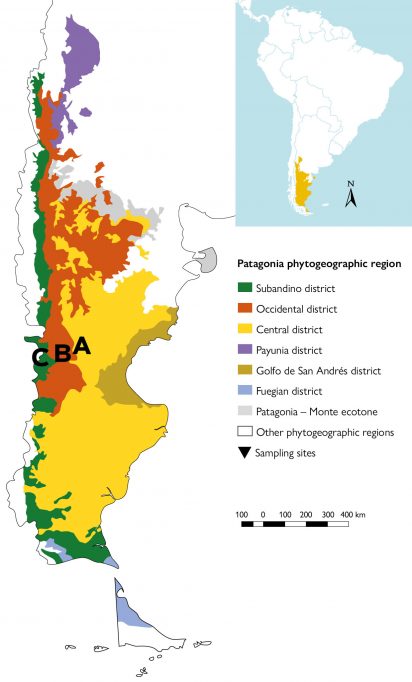Intensification of livestock farming in times of climate change
The challenges of domestic grazing in the drylands of the Argentine Patagonia
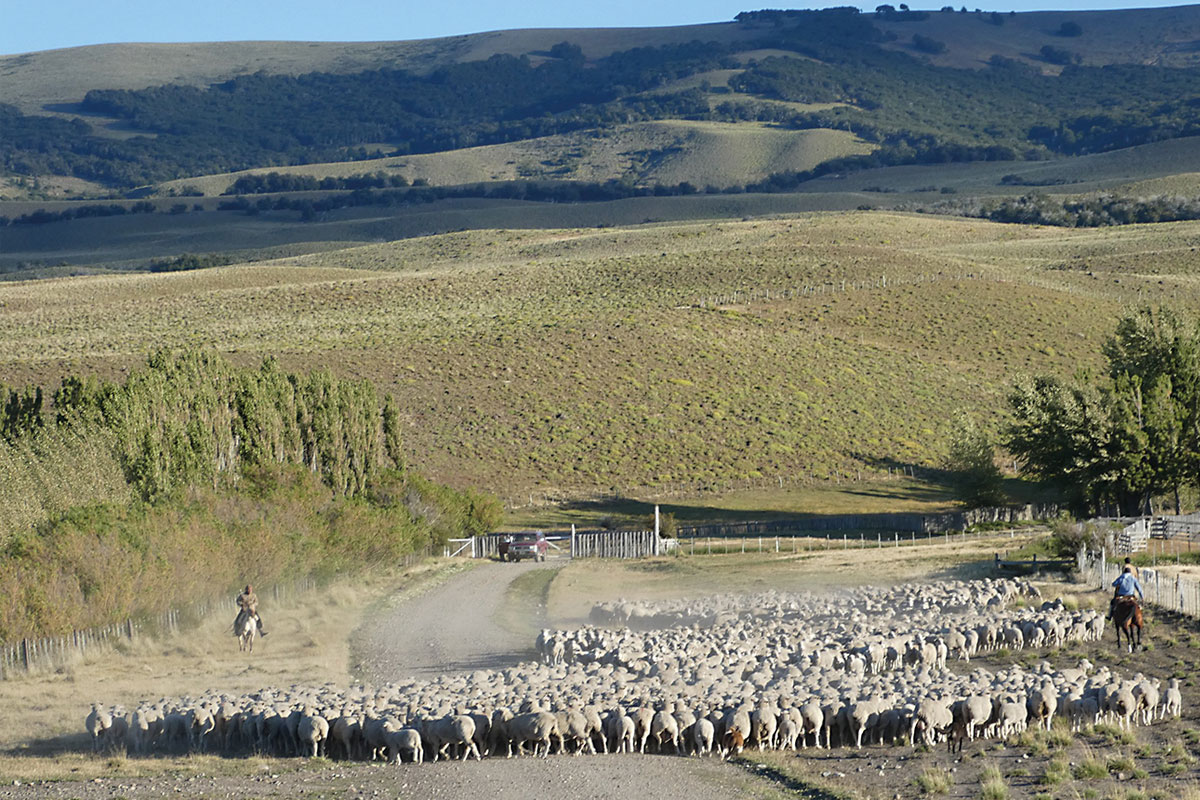
Livestock grazing modifies and even degrades arid ecosystems, which threatens the sustainability of livestock farming itself. It is essential to learn more about the effects of grazing on vegetation and soil to design strategies to avoid desertification, perhaps the most serious problem faced by drylands. In this paper, we evaluate the changes in the functional traits of the plant community and the biological soil crust induced by the intensification of grazing in Patagonian ecosystems. This description, together with changes in diversity, plant composition, and ecosystem functioning, can help us to understand the mechanisms by which the intensification of sheep grazing could degrade arid ecosystems.
Keywords: Patagonian Steppe, functional diversity, biological soil crusts, sheep production, desertification.
Introduction
Most of the vast territory of the Argentine Republic has an arid, semi-arid, or sub-humid climate and is mainly dedicated to extensive animal husbandry. The Patagonian Steppe Ecoregion, which occupies 30 % of the national territory, is the driest part and extends across the south of the country (Figure 1). Its extreme climatic conditions are characterised by low and highly variable rainfall (between 120 mm and 600 mm per year), high potential evapotranspiration, temperatures that are very high at some times of the year and very low at others, and a generally broad daily temperature range. In addition, the predominance of strong winds, mainly from the west, accentuates the aridity (León et al., 1998). These characteristics make the ecosystems of the Patagonian Steppe unsuitable for many productive activities. However, extensive sheep farming based on native forage species is widespread in the region and is combined in some areas with the use of wild animal populations for human consumption. The guanaco (Lama guanicoe) is the main native herbivore and its presence for about 10,000 years has shaped a long evolutionary history of grazing in these steppes.

Figure 1. Phytogeographic regions of the Argentine Patagonia (adapted from León et al., 1998, and Oyarzabal et al., 2018). Location of the study sites along the aridity gradient, covering (from east to west) the Central, Occidental, and Subandino regions, with arid, semi-arid, and dry sub-humid climates, respectively. / Photos: Sergio Velasco Ayuso
Livestock activity and its importance for the economy of the region
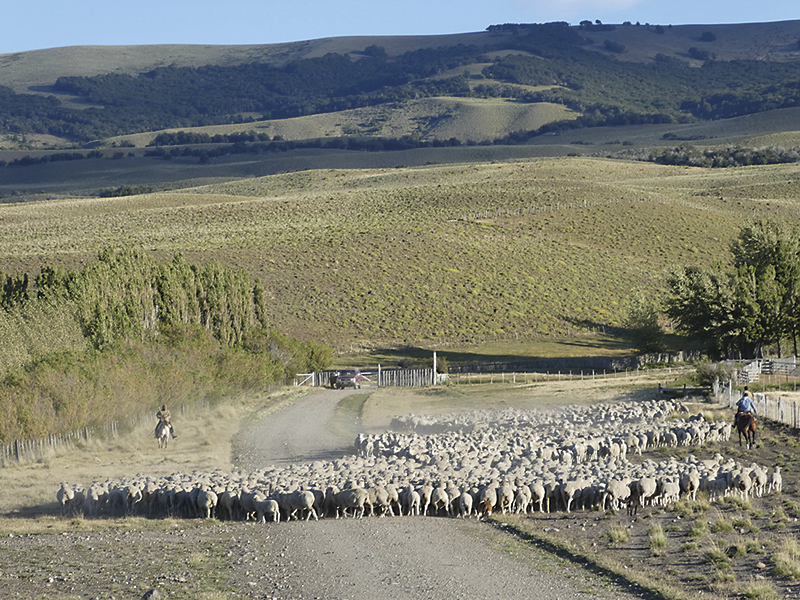
Figure 2. The Patagonian steppes are used for the production of sheep wool and meat. The consequences of grazing intensification in a context of climate change remain to be determined. This image shows sheep grazing in a Patagonian ranch of the dry sub-humid Subandino region of Patagonia, Argentina. / Photo: Sergio Velasco Ayuso
Sheep rearing is the predominant economic activity in the Patagonian Steppe and is primarily geared towards wool production, which is of great importance as part of the region’s cultural heritage (Figure 2). Animal husbandry is based on what the natural ecosystems produce. Since the introduction of sheep at the end of the 19th century, their populations steadily increased until the mid-20th century. However, they declined drastically during the following decades as a result of the generalised degradation of resources and the reduction of the forage provisioning service (Gaitán et al., 2018; Oñatibia et al., 2020). Sheep farming currently involves approximately eight million animal units, with a production of 24,000 tons of wool with rising production levels (Censo Nacional Agropecuario, 2018). The stocking rate in the area, or the number of animals per unit of surface area, is directly related to grazing pressure, an aspect of management that determines the impact of grazing on vegetation, soils, and animal performance (Oñatibia, 2021). In general, domestic grazing with a moderate stocking rates (up to 0.4 sheep/ha) is the most efficient option for land use in the Patagonian shrub-grass steppes, considering both ecological and socioeconomic factors (Oñatibia, 2021).
Plant physiognomy
In southern Argentina, rainfall concentrates during the winter, between June and September, and notably decreases from west to east, resulting in a huge variability in aridity levels within just a few kilometres. These changes in rainfall are associated with notable differences in vegetation that give rise to vegetation subunits, known as phytogeographic districts (León et al., 1998; Oyarzabal et al., 2018; Figure 1). In this current work, we focused on the region located south of the province of Chubut, which contains different vegetation units belonging to the Central, Occidental, and Subandino districts of the Patagonian phytogeographic region (Figure 1). There is a transition from shrublands to grass steppes, with increases in vegetation cover and net primary productivity from the most arid area in the eastern Central region to the humid Subandino region in the west (Austin & Sala, 2002) (Table 1).
Global change: Drought and intensification of grazing activity
Intensification of the use of grasslands for livestock is a consequence of high stocking rates relative to the carrying capacity of the fields used for livestock production. This phenomenon has increased in recent decades, and is expected to become a continued problem in the future. This increase is a consequence of the demand for safe and high-quality animal products which, in combination with climate change, produces accelerated ecological and social effects. Patagonian ecosystems in particular are seriously threatened by an increase in aridity as a result of rising average temperatures and increases in the frequency and intensity of extreme droughts (Yahdjian & Sala, 2008). Thus, over time, the combination of climate variations and inappropriate human activity can lead to desertification and the irreversible deterioration of drylands (Huang et al., 2016; Maestre et al., 2016).
| District | Climate | Aridity index | Net aboveground primary production (g m-2 year-1)▲ | Average annual rainfall (mm/year)◆ |
Type of vegetation and characteristic species |
| Central | Arid | 0.15 | Low (22) | 125 | Shrublands
(Nassauvia glomerulosa, N. ulicina and Chuquiraga aurea) |
| Occidental | Semi-arid | 0.35 | Intermediate (56) | 170 | Shrub-grass steppes (grasses: Pappostipa speciosa, P. humilis and Poa ligularis; shrubs: Azorella prolifera, Adesmia volckmannii and Senecio filaginoides) |
| Subandino | Dry sub-humid | 0.5 | High (100) | 360 | Grasslands
(characteristic species Festuca pallescens, together with Lathyrus magellanicus and Rytidosperma pictum. Low cover of shrubs of the species Senecio sericeonitens and Azorella prolifera) |
Table 1. Phytogeographic districts of the Argentine Patagonia included in this study. Climate and vegetation characteristics of the study sites located along the aridity gradient of the Patagonian phytogeographic region, in the Central, Occidental, and Subandino districts.
▲ The aridity index is estimated as the precipitation/potential evapotranspiration ratio (Le Houérou, 1996).
◆ The net aboveground primary productivity is estimated from the accumulated plant biomass per unit of land during a given growing season.
Aridity is the main determinant of productivity and composition in plant communities, but domestic grazing can lead to changes in the diversity and relative cover of plant functional groups (Carboni, 2019). Net aboveground primary productivity is a key aspect of terrestrial ecosystem functioning that determines animal biomass, secondary productivity, and nutrient cycling, thereby conditioning livestock production.
The forage demand for livestock adds to the demand for other ecosystem services in the region, such as the maintenance of biodiversity for tourism or recreational use, regulation of carbon emissions, and supply of drinking water (Yahdjian et al., 2015). Attaining sustainable management in the context of climate change is a major challenge that has led to the study of sheep domestic grazing in the Patagonian drylands. This area of study considers vegetation, biological soil crusts, and several aspects of ecosystem functioning, the results of which are summarised below.
Consequences of the intensification of grazing
Intensified grazing pressure and high aridity have a negative effect on vegetation and, as a consequence, collectively induce the degradation of forage resources (Oñatibia et al., 2020). However, in semi-arid and sub-humid steppes, livestock management with light to moderate stocking rates (between 0.2 and 0.4 sheep/ha) maximises the provision of some ecosystem services. Indeed, in shrub and shrub-grass steppes, grazing at moderate intensities increases net primary productivity, plant species richness, forage provision, and carbon sequestration, compared to ungrazed or heavily grazed land (with more than 0.5 sheep/ha; Oñatibia, 2021). These findings contradict the assumption that domestic grazing has a negative impact on Patagonian rangelands. This contradiction is partly due to the fact that the generally accepted idea of degradation induced by domestic grazing comes from studies comparing exclosures (areas where livestock are totally excluded) with grazing situations (Cesa & Paruelo, 2011), with no precise estimation of grazing intensity or pressure. Assessing the impact of different grazing intensities (e.g., grazing exclusion, light, moderate, and heavy grazing) allows for the detection of non-linearities and possible positive effects of domestic herbivores (Oñatibia, 2021). Thus, our studies assessed the changes in plant functional groups, biological soil crust, and functional diversity (as described below) along a grazing intensity gradient at sites of contrasting aridity.
Effects of grazing on plant functional groups
In general, grazing and aridity are both expected to have equally negative consequences on the structure and functioning of arid ecosystems in Patagonia, because both factors lead to reductions in species richness, palatable grass cover, and soil functioning (Flombaum et al., 2017; Gaitán et al., 2018). However, grazing did not have similar effects on total vegetation cover (Carboni, 2019; Figure 3) in the context of the regional rainfall gradient of the Patagonian Steppe (Table 1; Figure 1). Increased aridity and the intensification of domestic grazing did cause a decrease in the total cover of herbaceous plants, especially of the palatable grasses preferred by livestock (Figure 3). However, grazing also led to an increase in the relative cover of shrub species, which partly compensated for the loss of the herbaceous cover (Figure 3). In the most extreme situation, i.e., at sites with high aridity and high grazing pressure, there was a loss of total vegetation cover in excess of 50 %, and even a decrease in shrub cover, which leads to desertification processes. In contrast, in semi-arid and sub-humid drylands, the reduction of palatable pasture was partly compensated by increases in the cover of grasses less preferred by livestock, in addition to shrubs (Figure 3).
Effects on the plant functional traits
Changes in plant physiognomy along the aridity gradient (Figure 1) and in the coverage of plant functional groups as the result of grazing intensification (Figure 3) also have consequences to the functional diversity of vegetation. The mechanism of changes in plant trait composition, rather than species composition, could help explain changes in Patagonian steppes functioning after grazing. Therefore, to describe changes in vegetation functional diversity, we measured a series of traits of dominant plant species (defined as those that together account for 90 % of the vegetation cover). These traits, as follows, are related to the plants’ ability to use resources: maximum height, plant width, size (the sum of the height and width), leaf area, specific leaf area (ratio of leaf area to leaf weight), and leaf dry matter content. Forage quality is mainly determined by specific leaf area and moisture content, while plant architectural attributes strongly influence herbivore choice and consumption rate.
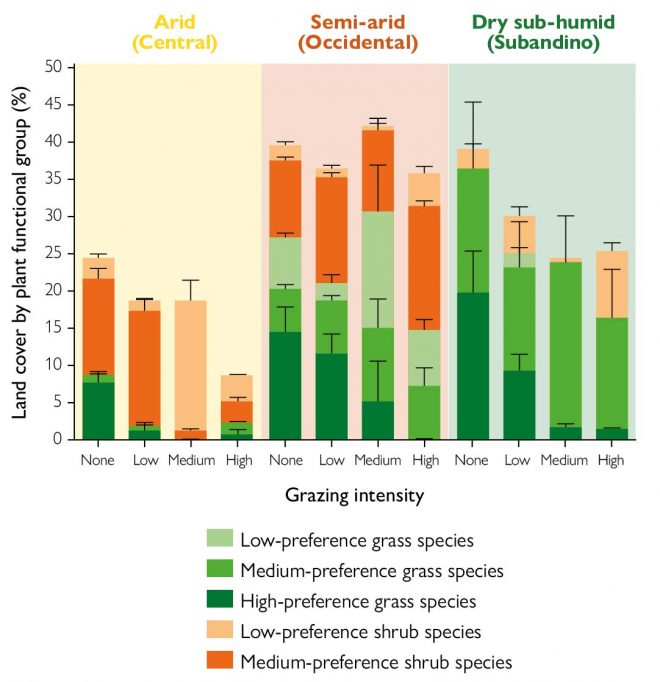
Figure 3. Land cover by plant functional group (%) as a function of grazing intensity (none, low, medium, and high grazing intensity) in sites with different aridity in the Argentine Patagonia (adapted from Carboni, 2019).
In the driest area, where vegetation is short (less than 30 cm tall) and there is a low plant cover (less than 30 %), intensification of grazing drastically reduced shrub cover and leaf dry matter but had no effect on shrub size or leaf area. Conversely, the intensification of grazing at this location of the aridity gradient clearly produced a reduction in the size and leaf area of herbaceous plants, which is aggravated by the low availability of this forage resource. In the semi-arid area, where plant height is 60–180 cm and plant cover is about 50 %, the main effect of intensified grazing was an increase in shrub size, cover, and leaf area. In contrast, the effects of grazing on herbaceous traits were less marked, although there was a decrease in cover and plant size in heavily grazed conditions. A similar effect occurs at the sub-humid drylands, where grazing increases shrub leaf size and moisture content, but because shrub cover is very sparse, the response at the community level is not as evident as it is in the driest area. In contrast, the effect on herbaceous traits at this site shows the other side of the growth processes of shrubs, with clear decreases in plant cover and size, even with light to moderate grazing, with very pronounced changes being detected with heavy grazing (Figure 4).
Effects on biological soil crusts and the ecosystem
The biological soil crusts are a consortium of micro- and macro-organisms intimately associated with soil particles. They develop in the first few centimetres of soil in almost every biome around the world but are especially prominent in arid and semi-arid regions, where they can cover large areas. For this reason, they are commonly known as the living skin of the soil. These crusts, or skins, are very well adapted to their environment and can withstand extreme humidity, temperature, and insolation conditions. However, the biological soil crusts are very susceptible to compressive forces, such as those caused by animal trampling, and usually respond negatively to intensive land use, as several studies have shown in arid areas around the world (Velasco Ayuso et al., 2020).
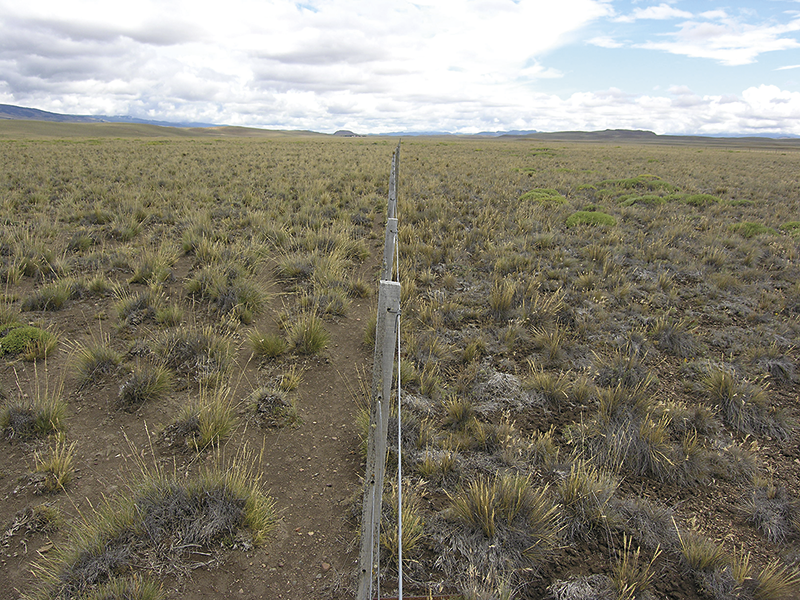
Figure 4. Areas of sub-humid grasslands subjected to different grazing intensities. The area on the left of the wire was subjected to greater grazing pressure. The reduced cover and size of the plants as a consequence of increased livestock pressure is evident. / Gastón R. Oñatibia
In the Patagonian Steppe, we found that sheep grazing significantly reduces the cover, biomass, and richness of functional types of biological soil crusts along the aridity gradient south from the Chubut province (Figure 1; Velasco Ayuso et al., 2020). Furthermore, the higher the grazing intensity, the greater the reduction in these parameters, with sheep grazing at low or moderate stocking rates having a lower impact than grazing at high stocking rates. Therefore, there is a direct relationship between the degradation of the biological soil crusts and the intensity of sheep grazing in Patagonian Steppe rangelands. Moreover, we have observed that the greatest impacts on these biological soil crusts caused by sheep grazing, regardless of its intensity, occured in the less arid zone of the gradient.
Combining the effects on vegetation and biological soil crusts, we can state that 1) high intensity sheep grazing has dramatic consequences on the biological crusts and plant functional diversity in rangelands of the Patagonian Steppe along the aridity gradient; and 2) low aridity conditions are insufficient to compensate for the negative effects that sheep grazing has on soil biocrusts and forage resources in this region. Although plant size in sub-humid drylands is not greatly affected by intensified grazing, the reduction in cover, specific leaf area, and all the variables associated with the biocrusts is very noticeable.
Implications of the deterioration for animal production and other ecosystem services
Because of its socioeconomic relevance, animal production plays a key role in determining the wellbeing of local producers in Patagonian rangelands. As a consequence, grazing pressure is often intensified to achieve higher secondary productivity (e.g., meat or wool) per unit area in the short term. However, such intensification substantially reduces the critical functions of these ecosystems and their natural forage capital, which is the foundation of sheep production in Patagonia. Our work also proves that intensive grazing has a negative effect on the structure and ecological function of the biocrusts in the Patagonian Steppe. In this sense, livestock intensification is not sustainable because increasing secondary production in the short term reduces the critical services that sustain it in the long term. This trade-off suggests that it will be critical to consider the time dimension in the appropriation of ecosystem services such as the forage provision to sustain livestock activity in the future (Oñatibia, 2021).
Conclusions
Arid rangelands are being threatened by a new wave of desertification caused by the intensification of livestock grazing in scenarios of increased aridity resulting from climate change (Huang et al., 2016). The reported association between grazing intensity and aridity as determinants of the functionality of Patagonian steppes and the ecosystem services they provide indicates that scenarios of increased aridity and livestock intensification can indeed trigger drastic changes (Gaitán et al., 2018; Maestre et al., 2012; Oñatibia et al., 2020). Our results concerning the effects on soil biocrusts and plant functional diversity suggest that grazing pressure should be adjusted according to the level of aridity. While semi-arid ecosystems can sustain moderate grazing intensities, arid ecosystems can only sustain very low intensities to avoid losing functionality or substantially reducing the provision of ecosystem services. The patterns observed also indicate that an increase in aridity or prolonged droughts may demand a further reduction in domestic grazing pressure, because under these scenarios, plant tolerance does not compensate for the effect of moderate grazing (Oñatibia, 2021). Thus, biotic stresses caused by herbivores can be decoupled from abiotic stresses induced by drought in order to maintain the functionality of Patagonian rangelands.
Acknowledgements
This study was funded by the Argentine National Agency for the Promotion of Science and Technology (PICT 2019-02324), University of Buenos Aires (20020190100212BA), and National Scientific and Technical Research Council (PIP 2015-0709). We are deeply grateful to Fernando T. Maestre for leading the BIODESERT project and inviting us to participate, and to Victoria Ochoa, Beatriz Gonzalo, and other technicians from Fernando T. Maestre’s laboratory for their analysis of vegetation samples. We would like to thank the National Agricultural Technology Institute (INTA) and the producers of the Patagonian land for allowing us to work at their sites, and Mariana B. Ciavattini and Pedro M. Tognetti for their help during the fieldwork campaigns in Patagonia.
References
Austin, A. T., & Sala, O. E. (2002). Carbon and nitrogen dynamics across a natural precipitation gradient in Patagonia, Argentina. Journal of Vegetation Science, 13(3), 351–360. https://doi.org/10.1111/j.1654-1103.2002.tb02059.x
Carboni, L. (2019). La intensificación del pastoreo produce efectos diferenciales en la cobertura y composición vegetal en un gradiente regional de aridez. [Undergraduate dissertation in Environmental Sciences, Faculty of Agronomy, University of Buenos Aires]. Argentina.
Censo Nacional Agropecuario. (2018). Resultados preliminares, ganadería. Instituto Nacional de Estadística y Censos – INDEC.
Cesa, A., & Paruelo, J. M. (2011). Changes in vegetation structure induced by domestic grazing in Patagonia (Southern Argentina). Journal of Arid Environments, 75(11), 1129–1135. https://doi.org/10.1016/j.jaridenv.2011.04.003
Flombaum, P., Yahdjian, L., & Sala, O. E. (2017). Global-change drivers on ecosystem functioning modulated by natural variability and saturating responses. Global Change Biology, 23(2), 503–511. https://doi.org/10.1111/gcb.13441
Gaitán, J. J., Bran, D. E., Oliva, G. E., Aguiar, M. R., Buono, G. G., Ferrante, D., Nakamatsu, V., Ciari, G., Salomone, J. M., Massara, V., García Martínez, F., & Maestre, F. T. (2018). Aridity and overgrazing have convergent effects on ecosystem structure and functioning in Patagonian rangelands. Land Degradation & Development, 29(2), 210–218. https://doi.org/10.1002/ldr.2694
Huang, J., Yu, H., Guan, X., Wang, G., & Guo, R. (2016). Accelerated dryland expansion under climate change. Nature Climate Change, 6, 166–171. https://doi.org/10.1038/nclimate2837
Le Houérou, H. N. (1996). Climate change, drought and desertification. Journal of Arid Environments, 34(2), 133–185. https://doi.org/10.1006
/jare.1996.0099
León, R. J. C., Bran, D., Collantes, M., Paruelo, J. M., & Soriano, A. (1998). Grandes unidades de vegetación de la Patagonia extra andina. Ecología Austral, 8(2), 125–144.
Maestre, F. T., Quero, J. L., Gotelli, N. J., Escudero, A., Ochoa, V., Delgado-Baquerizo, M., García-Gómez, M., Bowker, M. A., Soliveres, S., Escolar, C., García-Palacios, P., Berdugo, M., Valencia, E., Gozalo, B., Gallardo, A., Aguilera, L., Arredondo, T., Blones, J., Boeken, B., … Zaady, E. (2012). Plant species richness and ecosystem multifunctionality in global drylands. Science, 335(6065), 214–218. https://doi.org/10.1126/science.1215442
Oñatibia, G. R. (2021). Grazing management and provision of ecosystem services in Patagonian arid rangelands. In P. L. Peri, G. Martínez Pastur, & L. Nahuelhual (Eds.), Ecosystem services in Patagonia (pp. 47–74). Springer. https://doi.org/10.1007/978-3-030-69166-0_3
Oñatibia, G. R., Amengual, G., Boyero, L., & Aguiar, M. R. (2020). Aridity exacerbates grazing‐induced rangeland degradation: A population approach for dominant grasses. Journal of Applied Ecology, 57(10), 1999–2009. https://doi.org/10.1111/1365-2664.13704
Oyarzabal, M., Clavijo, J., Oakley, L., Biganzoli, F., Tognetti, P., Barberis, I., Maturo, H. M., Aragón, R., Campanello, P. I., Prado, D., Oesterheld, M., & León, R. J. C. (2018). Unidades de vegetación de la Argentina. Ecología Austral, 28(1), 40–63. https://doi.org/10.25260/EA.18.28.1.0.399
Velasco Ayuso, S., Oñatibia, G. R., Maestre, F. T., & Yahdjian, L. (2020). Grazing pressure interacts with aridity to determine the development and diversity of biological soil crusts in Patagonian rangelands. Land Degradation and Development, 31(4), 488–499. https://doi.org/10.1002/ldr.3465
Yahdjian, L., & Sala, O. E. (2008). Climate change impacts on South American Rangelands. Rangelands, 30(3), 34–39. https://doi.org/10.2111/1551-501X(2008)30[34:CCIOSA]2.0.CO;2
Yahdjian, L., Sala, O. E., & Havstad, K. M. (2015). Rangeland ecosystem services: Shifting focus from supply to reconciling supply and demand. Frontiers in Ecology and the Environment, 13(1), 44–51. https://doi.org/10.1890/140156

